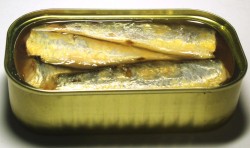All About Food | August 31st, 2016

With overfishing decimating seafood supplies around the world, the hottest new trend to hit our shores is tinned seafood. This is nothing new to the Europeans but it is taking hold here in the U.S. as fisheries find new ways to market their products in a manner that is as fresh as the first catch.
So what is the difference between tinned and canned? About five dollars and a whole lot of quality and flavor. This is not your run-of-the-mill ninety-nine cent can of tuna that went in little Johnny’s sandwich for lunch today. When we think of canned fish we expect it to be of inferior quality with bits of cartilage or just not at its peak freshness.
Our canned fish is the hot dog of seafood, but not in Europe. There it is recognized as seasonal and caught and tinned at the height of its freshness and flavor. Once tinned, either in olive oil or sea-salted water, that freshness will last for years, which is why American fisheries are getting on board.
Alaskan salmon has a short season, so outside of smoking their catch, savvy fishermen are tinning their catch at its peak freshness. American Tuna in Southern California is tinning its high-quality and expensive abalone and tuna in the Spanish style.
If you have ever tasted tinned tuna belly from Spain packed in olive oil you will probably never eat Sunkist again. It is not unusual to go out in Spain and order a tin of fish at a café for a late lunch or early dinner. Cafes and restaurants across Europe actually specialize in tinned fish, from squid to razor clams and even baby eels. Now the concept of “fish bars” is popping up all across the States, from Seattle to Boston.
Celebrity chef Tom Colicchio, well known from his role in the reality show Top Chef, and also for his numerous restaurants, has a commitment to sustainability. He is also trying to change the political mindset in Washington D.C., to have an equitable food policy. Colicchio uses American Tuna’s fish for his chain of high-end sandwich shops, Witchcraft.
With Maiden Lane restaurant in New York City importing tinned Spanish fish along with JarrBar in Seattle, this is a growing change in our culinary landscape, that shows a maturity and awareness among restaurateurs here in the States and their well-travelled clientele. Which will bring along other foodies and change our mindset about tinned fish.
This doesn’t mean you should rush off to the canned seafood aisle in your local grocery store. For some questionable items lurk on those shelves. My rule of thumb is to read the label. Find out where the fish was caught and equally as important who packed it. It is surprising to find that most Chicken of the Sea products are packed in Thailand and the ever prevalent Reese’s brands of oysters and clams come from Korea and China. Not knowing what these countries’ regulations are for canning foods or the quality of the food and the conditions it was harvested in, I am suspicious about them.
There are some good tinned fish out, in particular the Ortiz tuna available at Pinch & Pour in Downtown Fargo. Hornbachers carries the Coles brand, which is an American company importing fish from Portugal. I have tried all three of theirs and although they are not quite as good as the Ortiz they are good value and tasty.
Personally I look forward to a wave of high-end, quality-driven tinned seafood arriving on our shores and in our stores.
With the skyrocketing price and popularity of our native walleye perhaps we should be tinning it and exporting it. Walleye, the new tuna? Who knows, maybe Tom Colicchio would put it on his menu.
November 18th 2025
November 12th 2025
September 16th 2025
August 19th 2025
July 15th 2025
_(1)__293px-wide.png)

_(1)_(1)_(1)__293px-wide.jpg)
__293px-wide.jpg)

_(1)__293px-wide.png)